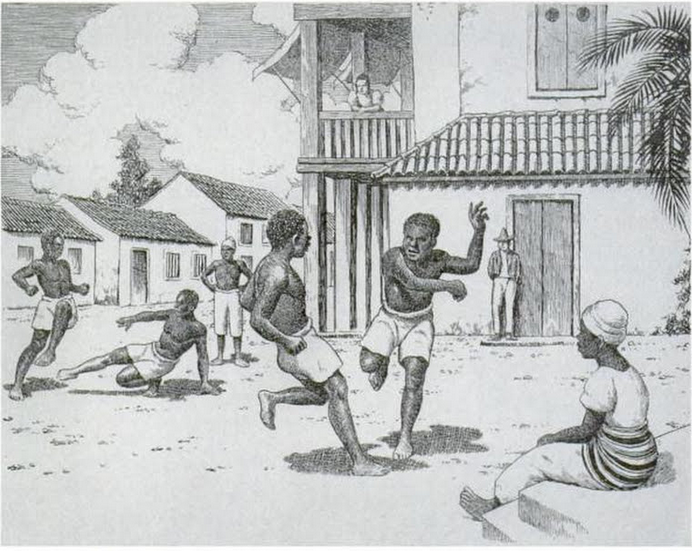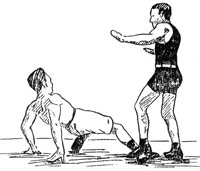
https://www.youtube.com/watch?v=78OlX_aIDHI
Corta capim was one of the primary low takedown of Capoeira Carioca. It is a clever modification of the 'coffee-grinder' sweep.
-
Here is how to do it:
The technique uses Snake archetype. Lean backward and drop onto the ground on your left hand, squatting on your left leg and swinging your right leg around to the front.
When the swinging leg gets to the front, shift your weight onto your right hand; then jump from your left leg and pull your right leg underneath your left leg; using the swing to bring you up onto your feet.
However! To do this properly, use Seduction1 modificator when jumping; this makes the jump more powerful, and it is important when applying the technique against an enemy.
-
The Snake+Seduction1 jump is the core of the technique;and it only works when you have your hands behind you, leaning backward (ie. it does not work for the 'coffee-grinder' sweep where your lean forward).
I repeat: In true Corta capim, you lean backwards on your hands; not forward.

(Picture from 19th century; in the backfround, Corta capim. Note how one arm is lifted, which confirms the following Seduction1 jump.)

(Corta capim from Anibal Burlamaqui's manual(1928))
-
Here is how you use the technique in combat.
The opponent is standing with his left foot forward.
Enter from opponent's left side; get down as described(Snake), swinging your right leg until it hits opponent's left heel, unbalancing him forward.
Then use Seduction1 and jump, pulling opponent's left leg with your right heel. The pull is not powered by the swing; but by the jump.
Your leg pulls heel-first, not toe first like a rasteira!
If you use Seduction1 properly during the jump, this pull both opponent's feet from under him and throws him onto the ground hard. (Without Seduction1, it still works, but it is only a mild pull).
I repeat once again: What powers the pull is not the swing of the leg; but the jump. This is the core of the technique.
Notes:
1) Corta capim must be done from the side, not from the front like Rasteira. Corta capim was never supposed to sweep the side of opponent's foot; it catches and pulls opponent's heel.
Because of its mechanics, Corta capim can only sweep the leg from the outside; unlike Rasteira that can take the leg both from inside and outside.
2) Pull his right heel forward with your right heel.
3) The technique works like rasteira; ie it pulls opponent's front leg, but due to its mechanics, it pull both opponent's feet from underneath him.
4) Corta capim is similar to Low rasteira; both first pull opponent's front leg with Snake, then throw him using a jump (Crane with rasteira, Seduction1 with corta capim).
However, corta capim differs from Low rasteira by the fact that rasteira enters from opponent's front; while Corta capim enters from the side.
5) Corta capim is used when the opponent attacks, ie it is a counter; it is not supposed to be applied against his on-guard stance (unless the opponent is a fish)
6) As noted, Corta capim is a clever modification of the coffee grinder sweep. While the coffee grinder itself can be used to sweep opponent's front leg (Snake) - this is probably done in some kungfu styles - it is not very powerful.
However, capoeiras modified the technique by adding Seduction1 modificator to the jump; this makes the resulting sweep a lot more powerful and the fall harder. (You can try the technique both with and without the Seduction1 modificator to see the difference).
Corta capim is a beautiful technique, embodying both the gymnastic, almost acrobatic side of the old Capoeira (using the jump in coffee grinder to pull opponent's feet from under him); but also its perchant for clever tricks that make its techniques work (here, it is the Seduction1 modification of the jump to make the technique more powerful).
Corta capim is a lot more clever than the kungfu version. (If they know how to use it as sweep at all).
7) Corta capim is a very fast sweep; it brings the opponent down quickly and puts you back on your feet (unlike rasteira). According to Anibal Burlamaqui, it is 'almost always used in a fights with multiple opponents'.
8) Some people wrongly use the name 'Corta capim' for Calço (Sinhozinho). True Corta capim is described in this article; it sweeps just the front leg (while Calco takes both legs).
9) Corta capim was clearly used in old Carioca; I was unable to find out whether it was used in Bahian capoeira (I mean in its true form, described here).
10) Corta capim was probably also called 'Rasteira a caçador' or just 'Caçador'(Placido de Abreu, 1886); Moraes Filho in Festas a tradicoes Populares do Brazil (1893) writes:
"'rasteira a caçador' - a quasi-gymnastic move where the capoeira falls back, propping himself up on his hands, and takes the opponent down using his foot by a violent blow targeting the joint between shin and heel'.
While the 'violent blow' part is a bit suspicious - Corta capim does not strike, it pulls - otherwise, the description fits; and it is hard to find any other low banda that would fit the description.
12) There are some modern attempts at 'Corta capim'; however, these are stupid movements that usually just chop into opponent's leg using your own leg. This does not work; as described here, true Corta capim pulls opponent's legs using the jump; it does not chop into the ankle.
13) Note that the Seduction1 jump that is clearly visible in the solo execution is not seen when you use Corta capim for real; as the energy of the jump goes into opponent's body and throws him. I believe this is why some authors (Burlamaqui included) describe Corta capim as just a swing of the leg; missing its true power source.
This Web Page was Built with PageBreeze Free HTML Editor